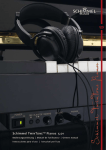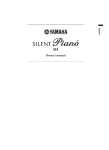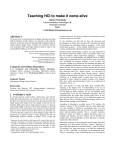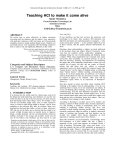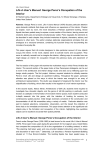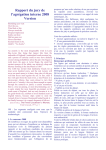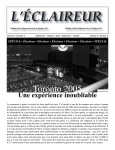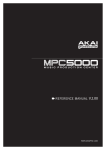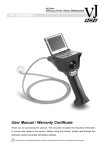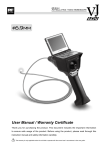Download Yamaha SILENT PIANO SG2 Owner`s manual
Transcript
SILENT_Piano_SG2_all.book Page 1 Friday, May 25, 2012 10:22 AM English SG2 Owner’s manual SILENT_Piano_SG2_all.book Page 2 Friday, May 25, 2012 10:22 AM SPECIAL MESSAGE SECTION This product utilizes an external power supply (adaptor). DO NOT connect this product to any power supply or adaptor other than one described in the manual, on the name plate, or specifically recommended by Yamaha. WARNING: IMPORTANT: Do not place this product in a position where anyone could The louder the sound, the shorter the time period before walk on, trip over, or roll anything over power cords or other damage occurs. connecting cords. The use of an extension cord is not recommended! If you must use an extension cord, the Some Yamaha products may have benches and/or accessory minimum wire size for a 25’ cord (or less) is 18 AWG. mounting fixtures that are either supplied as a part or the product or as optional accessories. Some of these items are NOTE: designed to be dealer assembled or installed. Please make The smaller the AWG number, the larger the current sure that benches are stable and any optional fixtures (where handling capacity. For longer extension cords, consult a applicable) are well secured BEFORE using. Benches local electrician. supplied by Yamaha are designed for seating only. No other uses are recommended. This product should be used only with the components supplied or; a cart, rack, or stand that is recommended by NOTICE: Yamaha. If a cart, etc., is used, please observe all safety Service charges incurred due to lack of knowledge relating to markings and instructions that accompany the accessory how a function or effect works (when the unit is operating product. as designed) are not covered by the manufacturer’s warranty, and are therefore the owners responsibility. Please study this SPECIFICATIONS SUBJECT TO CHANGE: manual carefully and consult your dealer before requesting The information contained in this manual is believed to be service. correct at the time of printing. However, Yamaha reserves the right to change or modify any of the specifications without notice or obligation to update existing units. ENVIRONMENTAL ISSUES: Yamaha strives to produce products that are both user safe and environmentally friendly. We sincerely believe that our Do not attempt to service this product beyond that products and the production methods used to produce described in the user-maintenance instructions. All other them, meet these goals. In keeping with both the letter and servicing should be referred to qualified service personnel. the spirit of the law, we want you to be aware of the following: This product, either alone or in combination with an amplifier and headphones or speaker/s, may be capable of Disposal Notice: producing sound levels that could cause permanent hearing Should this product become damaged beyond repair, or for loss. DO NOT operate for a long period of time at a high some reason its useful life is considered to be at an end, volume level or at a level that is uncomfortable. If you please observe all local, state, and federal regulations that experience any hearing loss or ringing in the ears, you relate to the disposal of products that contain lead, batteries, should consult an audiologist. plastics, etc. If your dealer is unable to assist you, please contact Yamaha directly. PLEASE KEEP THIS MANUAL 2 SILENT_Piano_SG2_all.book Page 3 Friday, May 25, 2012 10:22 AM Chapter 1 Getting Started English Contents Chapter 1 Getting Started .........................3 Chapter 3 Recording and Playback.......... 13 Accessories .........................................................3 Recording a Performance ................................. 13 Installation .........................................................3 Playing Back the Song Recorded in the Internal Part Names ........................................................4 Memory .......................................................... 14 Attaching the Headphones Hanger ....................6 Connecting the USB Memory ......................... 15 Setting the Auto Power-off Function ..................6 Saving Recorded Data to the USB Memory..... 16 Connecting the AC Adaptor ..............................7 Playing Back Songs in the USB Memory ......... 17 Chapter 2 To Begin Playing .......................8 Playing Back Demonstration Songs Using the Silent Piano Function.........................8 (Demonstration Mode).................................... 19 Selecting Voices..................................................9 Chapter 4 Connecting to Other Devices .. 21 Adjusting the Brilliance....................................10 Connecting to Other Audio Devices................ 21 Setting the Amount of Reverb..........................11 Connecting to Other MIDI Devices................ 23 Adjusting the Pitch (Tuning)............................11 Chapter 5 Appendix ............................... 24 Setting the DDE (Dynamic Damper Effect) ....12 Troubleshooting............................................... 24 Returning Settings to Their Default The Error Chime............................................. 25 Configuration (Reset All) .................................12 Preset Voice List............................................... 26 Demonstration Song List................................. 27 MIDI Data Format (Program Change)............ 28 MIDI File Playback Sequence.......................... 28 Specifications................................................... 29 Accessories • AC adaptor (PA-150 or an equivalent recommended by Yamaha) × 1 • Headphones × 1 • Headphones hanger × 1 • Attachment screws for headphones hanger × 2 • Owner’s manual × 1 Installation • Avoid placing this instrument in direct sunlight, in close proximity to heating equipment or other hightemperature areas, or in locations with a high degree of humidity. • Avoid placing this instrument in dusty or dirty areas. • Do not expose this instrument to spray or fumes. • Use only the specified AC adaptor. Use of other AC adaptors may result in damage, overheating, or fire. 3 SILENT_Piano_SG2_all.book Page 4 Friday, May 25, 2012 10:22 AM Part Names ■ Piano Upright piano Grand piano 2 (on the rear of the piano) 1 (for models equipped with a sostenuto pedal) Control box (page 5) Control box (page 5) 1 Silencing lever 1 2 DC12V jack (for upright pianos) Activates the Silent Piano™ function. Connect the supplied AC adaptor. ■ Pedals 3 1 Damper pedal Sustains notes even after you release the keys. While performing with the piano voice, this recreates a sympathetic resonance occurs in adjacent strings on an acoustic piano (Dynamic Damper Effect). 2 Silencing pedal (For models not equipped with a sostenuto pedal) Activates the Silent Piano™ function. 4 2 1 3 Shift pedal / soft pedal Softens the piano sound. While using the voices other than piano, you can use this pedal to switch between the normal voice and a variation (see page 9). SILENT_Piano_SG2_all.book Page 5 Friday, May 25, 2012 10:22 AM ■ Control box Front panel Bottom panel English USB 7 OFF 2 3 4 5 6 13 ON 1 AUTO OFF MODE MIDI IN 8 MIDI OUT DC IN 12V IN AUX OUT 1 POWER switch 2 REC button Places the instrument in record standby mode. This is a combination lamp and button. The manner in which the lamp is lit indicates the recording state of the unit. 3 PLAY/STOP button Starts and stops playback. This is a combination lamp and button. The manner in which the lamp is lit indicates the current state of the unit. 4 REVERB knob Adjusts the amount of reverb. 5 VOLUME knob Adjusts the volume for both headphones simultaneously. 6 PHONES jacks You can connect two stereo headphones, allowing you to share your playing with another person. KEY 10 Used to turn the digital piano on and off. PDL 9 11 12 8 MIDI IN/MIDI OUT jacks Connect to the input / output jacks of external MIDI devices. 9 AUX IN/AUX OUT jacks Connect to the input / output jacks of external audio devices. 10 DC IN 12V jack (for grand pianos) Connect the supplied AC adaptor. 11 KEY jack Key sensor jack. 12 PDL jack Pedal sensor jack. 13 AUTO OFF MODE switch Activates or inactivates the auto power-off function. Set this switch to ON to turn the power off automatically if you do not operate the unit for 30 minutes. 7 USB terminal Insert USB memory here. 5 SILENT_Piano_SG2_all.book Page 6 Friday, May 25, 2012 10:22 AM Attaching the Headphones Hanger Attach the hanger to the underside of the control box with the two screws supplied. AU TO DE ON F OF OF F MO MIDI MIDI AU IN B US IN OU T X OUT Screwdriver Setting the Auto Power-off Function You can turn the power off automatically if you do not operate the unit for 30 minutes. Set the AUTO OFF MODE switch at the bottom of the control box. ON: Activates the auto power-off function. The unit is automatically turned off if you do AU TO OF DE ON F OF F MO MIDI MIDI B US IN not operate it for 30 minutes. While the OU T X OUT the power off and on again with the POWER switch. OFF: Inactivates the auto power-off function. Use the POWER switch to turn the power off. If you turn the power on while the AUTO OFF MODE switch is set to OFF, the PLAY/STOP lamp on the front of the control box lights up for 2 seconds. 6 ON FF O Note AU IN auto power-off function is activated, turn SILENT_Piano_SG2_all.book Page 7 Friday, May 25, 2012 10:22 AM Connecting the AC Adaptor ■ For Upright Pianos Connect the AC adaptor to the DC12V jack at the rear of the piano. 2 Loop the cord through the hook on the piano, as shown. 3 Connect the AC adaptor to the AC wall outlet. English 1 DC12V 1 3 2 ■ For Grand Pianos 1 Connect the AC adaptor to the DC IN 12V jack at the rear of the control box. DC IN 12V IN AU X OU T AU MIDI TO OF OU T F MO DE ON OF F MIDI IN US B 2 Connect the AC adaptor to the AC wall outlet. Caution • Use the Yamaha PA-150 AC adaptor, or an equivalent recommended by Yamaha. Use of other AC adaptors may result in damage, overheating, or fire. • Do not stretch the cord or bend its ends. • Do not attempt to use the cord if it is stretched or if the ends of the cord have been bent. Attempting to do so may cause interruptions to the power supply. • Always turn off the main unit power before disconnecting the AC adaptor. • When you wish to move the Silent Piano, unplug the AC adaptor from the AC outlet and disconnect it from the DC12V jack at the rear of the piano, or the DC IN 12V jack at the rear of the control box before proceeding. • Unplug the AC adaptor from the AC outlet if you do not intend to use the instrument for an extended period of time. 7 SILENT_Piano_SG2_all.book Page 8 Friday, May 25, 2012 10:22 AM Chapter 2 To Begin Playing Using the Silent Piano Function 1 (For models equipped with a sostenuto pedal) Pull the silencing lever towards you until you hear a click and feel the mechanism catch. (For models not equipped with a sostenuto pedal) Press the center pedal and slide it to the left. This prevents the hammers from actually striking the strings. 2 Plug the headphones into the PHONES jack. You can use two sets of headphones simultaneously. 0 E-17 HP 3 Turn the power on. The POWER lamp lights green. When the AUTO OFF MODE switch on the bottom of the control box is set to OFF, the PLAY/STOP lamp lights up for 2 seconds. 4 Adjust the volume with the VOLUME knob. Caution • The sound is not output properly if you hold down the keyboard while turning the power on. Remove your hand from the keyboard when turning the power on. • When you connect two sets of headphones simultaneously, use the same type of headphones for optimum performance. • The keying sound of the keyboard remains even though the Silent Piano function is activated. • To prevent damage to your hearing, refrain from raising the volume to excessive levels, and do not use the headphones for extended periods of time. • Do not pull the headphone cord or apply excessive force on the plug. This can damage the headphone and lead to sound output malfunction. 8 SILENT_Piano_SG2_all.book Page 9 Friday, May 25, 2012 10:22 AM Selecting Voices When using the Silent Piano function, you can use the internal voices of this unit to perform with voices other Voice name Setting method Piano (default setting) Hold down the A-1, A#-1, and B-1 keys and press C4. Harpsichord Hold down the A-1, A#-1, and B-1 keys and press D4. Vibraphone Hold down the A-1, A#-1, and B-1 keys and press E4. Pipe organ Hold down the A-1, A#-1, and B-1 keys and press F4. Celesta Hold down the A-1, A#-1, and B-1 keys and press G4. Strings Hold down the A-1, A#-1, and B-1 keys and press A4. Electric piano 1 Hold down the A-1, A#-1, and B-1 keys and press C#4. Electric piano 2 Hold down the A-1, A#-1, and B-1 keys and press D#4. Jazz organ Hold down the A-1, A#-1, and B-1 keys and press F#4. Choir Hold down the A-1, A#-1, and B-1 keys and press G#4. English than that of a piano. Note • • • • Select voices with the unit turned on. Turning the instrument off resets voice selection, which returns to piano the next time you turn the unit on. See “Preset Voice List” on page 26 for details on voices. You can also select two voices simultaneously for performance. See “Dual voice” on page 10. Caution • You can change voices while performing. This function is not available for songs that are being played back. • For voices other than piano, the shift/soft pedal alters the voice variation rather than dampening the tone. • For voices other than piano, the volume of the sound for the three lowest keys has been lowered intentionally. A#-1 A-1 B-1 C4–A4 9 SILENT_Piano_SG2_all.book Page 10 Friday, May 25, 2012 10:22 AM ■ Voice variation This unit provides variations on voices for your enjoyment when playing other voices than piano. See “Preset Voice List” on page 26 for details on variations. The voice alternates between normal and a variation every time you press the shift/soft pedal (the pedal at far left). The PLAY/STOP lamp lights briefly when you change between a normal voice and its variation. Green indicates the normal voice, while orange indicates that a variation has been selected. Note There are variations available for each voice. Turning off the unit resets variation selection. ■ Dual voice This function allows you to combine two voices while playing. Press two keys simultaneously to select two voices. Caution As the dual voice function uses two voices for every note played, the number of notes you can play simultaneously is reduced by half. Adjusting the Brilliance You can adjust the timbre brilliance of the sound from mellow to bright. Operation Setting method Adjusting the brilliance (5 levels) Hold down the A-1, A#-1, and B-1 keys and press C1, D1, E1, F1 or G1. (The normal setting is E1. C1 is the mellowest brilliance setting and G1 is the brightest brilliance setting. The default setting is E1.) Note This setting is applied to all voices, and does not change when you turn the unit off. A#-1 A-1 B-1 Mellow Normal Bright Brilliance C1–G1 10 SILENT_Piano_SG2_all.book Page 11 Friday, May 25, 2012 10:22 AM Setting the Amount of Reverb Reverb adds echo to the sound to give it more fullness and reverberation. English Use the REVERB knob to adjust the depth (the degree to which the reverb effect is applied to the sound). To turn the reverb off, set the control in the far left position. You can also change the type of reverb to apply. Reverb type Effect Setting method Room Reverberation similar to that heard in a normal Hold down the A-1, A#-1, and B-1 keys and press C2. room Hall 1 (default setting) Reverberation similar to that heard in a small concert hall Hold down the A-1, A#-1, and B-1 keys and press D2. Hall 2 Reverberation similar to that heard in a large concert hall Hold down the A-1, A#-1, and B-1 keys and press E2. Stage Reverberation similar to that heard on a stage Hold down the A-1, A#-1, and B-1 keys and press F2. Note The reverb type reverts to its default setting when you turn the power off. A#-1 A-1 B-1 C2 (Room) F2 (Stage) D2 (Hall 1)-default E2 (Hall 2) Adjusting the Pitch (Tuning) The pitch of this instrument is set so that A3=440Hz. You can fine tune the pitch up or down 65 cents (100 cents is equal to 1 semitone). Operation Setting method Raise the pitch Hold down the A-1 and B-1 keys and press any one of the keys between C3 and B3. Lower the pitch Hold down the A-1 and A#-1 keys and press any one of the keys between C3 and B3. Return to default tuning Hold down the A-1, A#-1, and B-1 keys and press any one of the keys between C3 and B3. Note The pitch setting is stored when you turn the instrument off. A#-1 A-1 B-1 C3–B3 11 SILENT_Piano_SG2_all.book Page 12 Friday, May 25, 2012 10:22 AM Setting the DDE (Dynamic Damper Effect) The DDE (Dynamic Damper Effect) recreates the subtle resonances that occur when you depress the damper pedal on an acoustic piano. You can set the DDE to suit your preferences. Operation Setting method Turn the DDE off Hold down the A-1, A#-1, and B-1 keys and press C6. Turn the DDE on (5 levels) Hold down the A-1, A#-1, and B-1 keys and press D6, E6, F6, G6 or A6. (A6 is the deepest DDE setting. The default setting is E6) Note • The DDE setting does not change when you turn the power off. • Even when the DDE is turned off, the sound continues as if you had pressed the damper pedal, but without any resonating effect. A#-1 A-1 B-1 C6 D6–A6 Returning Settings to Their Default Configuration (Reset All) You can reset all settings to their default state. Hold down the A-1, A#-1, and B-1 keys and press C7 for approximately 1 second, then release all the keys. This returns voice variation, brilliance, reverb type, pitch, and DDE to their default settings. A#-1 A-1 B-1 12 C7 SILENT_Piano_SG2_all.book Page 13 Friday, May 25, 2012 10:22 AM Chapter 3 Recording and Playback English Recording a Performance You can record one song in the internal memory of this unit. Note • The recording function can store approximately 65 kilobytes (equal to approximately 21,000 notes), which equates to a song approximately 25 minutes in length, or 5 minutes in length for a song with a high tempo that contains many notes. • The recording also stores information on the voice selected during performance. • The data recorded is preserved even if you turn the power off or reset all parameters. Caution • Starting recording will delete the previously recorded song (the previous recording is not deleted if you cancel the recording without playing anything when the unit is in record standby mode). Please back up any data you do not want to delete to USB memory. See “Saving Recorded Data to the USB Memory” on page 16 for details. • You cannot use the recording function when USB memory is connected. Please remove the USB memory before recording. 1 Press the REC button. The unit changes to record standby mode, the REC lamp lights red, and the PLAY/STOP lamp blinks green. Note Press the REC button again to cancel record standby mode and return the unit to its normal state. 2 Press the PLAY/STOP button. The PLAY/STOP lamp lights green and recording starts. 3 Begin playing. During recording, a chime sounds when there is little storage space remaining in internal memory. As the amount of storage remaining decreases, the chime becomes faster, and the unit begins to write data automatically. 4 Stop playing, and press the PLAY/STOP button. You can also press the REC button to stop recording. The REC lamp blinks quickly, and the unit begins to write data. The REC lamp stops flashing when the unit finishes writing data. The data writing operation may take a few tens of seconds. Caution Do not turn this unit off while the REC lamp is flashing as this may corrupt the data or damage internal memory. 13 SILENT_Piano_SG2_all.book Page 14 Friday, May 25, 2012 10:22 AM Playing Back the Song Recorded in the Internal Memory This unit can playback demonstration songs and recorded data. Press the PLAY/STOP button. The PLAY/STOP lamp lights green and playback starts. To stop playback Press the PLAY/STOP button during playback. To pause playback Press C7 during playback. The PLAY/STOP lamp blinks. Press C7 or the PLAY/STOP button to restart playback. To fast-forward Press A#6 while holding down G#6 during playback or while playback is paused. Playback fast-forwards and the PLAY/STOP lamp blinks while you press A#6. Release A#6 to return the unit to its previous state (playback, or with playback paused). G#6, A#6 C7 Note • The REC button does not function during playback or while playback is paused. • When USB memory is connected to the unit, the data stored in USB memory is played back. See “Playing Back Songs in the USB Memory” on page 17. • The chime sounds three times in succession if there is no song present. 14 SILENT_Piano_SG2_all.book Page 15 Friday, May 25, 2012 10:22 AM Connecting the USB Memory Connecting commercially available USB memory to the unit allows you save recording data, and playback songs English stored on the memory. Insert the USB memory into the USB terminal at the bottom left of the control box. DE ON F F MO OF OF MIDI MIDI AU IN B US contents of the USB memory. During checking TO AU The unit automatically begins checking the IN OU T X OUT the PLAY/STOP lamp blinks rapidly, changing to a pale orange when the process is complete. USB memory Caution • • • • • Do not remove the USB memory or turn the power on or off during data transfer, as breakage may result. Do not insert and remove the USB memory too frequently as breakage may result. Be careful not to bump the USB memory with your legs when it is connected to the unit. Do not insert any objects other than the USB memory into the USB terminal, as it may become unusable. Check that the USB memory is free of memory and software protection before attempting to use it, as these kinds of protection will prohibit access to the memory. • This unit is USB 1.1 compliant. You can also connect USB 2.0 devices to it, however data will be transferred at USB 1.1 speeds. 15 SILENT_Piano_SG2_all.book Page 16 Friday, May 25, 2012 10:22 AM Saving Recorded Data to the USB Memory You should back up important data to a storage medium such as a computer, in addition to saving it on USB memory. Saving data to USB memory without backing it up other storage media means that there is a risk of losing the data through jarring and shocks. 1 Insert the USB memory into the unit. The PLAY/STOP lamp flashes orange, and lights pale orange when the unit has completed checking the memory. 2 Press the REC button. The unit changes to transfer standby mode, the REC lamp lights red, and the PLAY/STOP lamp blinks orange. Note Press the REC button once more to cancel transfer standby mode and return the unit to its normal state. 3 Press the PLAY/STOP button. The PLAY/STOP lamp flashes rapidly, and data begins to transfer from internal memory to the USB memory. As the data format is also changed during transfer, the transfer process may take some time (3 to 4 minutes for a 65 kilobyte file). The REC lamp goes out and the PLAY/STOP lamp lights pale orange when transfer is complete. Note • The data is stored as “USERSONG**.MID” in a folder named “USER FILES” on the USB memory. You can store up to 50 songs in this manner. “**” can be any number from 00 to 49, and increases sequentially as files are saved. • The unit will inform you that it cannot save any further songs when songs accumulate and the filenames reach “USERSONG49.MID”. • Attempting to save files when there are one or more files with the file names “USERSONG50.MID” through “USERSONG99.MID” in the folder will result in an error, and you will be unable to save the data. • You cannot delete files from this unit. Please connect the USB memory to a computer if you want to delete a file. Caution When transferring data from the USB memory to a computer, previously saved files may be overwritten if they have the same file names as the files being transferred. If you do not want to overwrite these files, take measures to prevent this from happening, such as changing the names of the files. 16 SILENT_Piano_SG2_all.book Page 17 Friday, May 25, 2012 10:22 AM Playing Back Songs in the USB Memory Carrying out playback operations (see page 14) when the USB memory is inserted into this unit plays back the last English saved song in the USB memory. You can also play back all songs in the USB memory from the start, or select the song for playback. ■ To play back the last saved song in the USB memory With the USB memory inserted into this unit, press the PLAY/STOP button. If no saved file is found in the USB memory, and another playable file (Standard MIDI File) exists, the unit begins playback of that file. If no such file exists, the unit returns to its normal state. ■ To play back all songs in the USB memory 1 With the USB memory inserted into this unit, hold down B6 and C7 (the two white keys at far right of the piano keyboard) while turning the unit on. 2 Release the keys 1 to 2 seconds after turning the unit on. Playback automatically begins at the song first saved to the USB memory. B6 C7 To quit the song playback Switch the unit off and then on again. To select the song for playback (direct song selection) Hold down the A-1 key, and press any of the keys from C0 through to C#4 corresponding to the number of a song. • “USERSONG**.MIDI” files in the “USER FILES” folder in the USB memory are assigned to the keys from C0 through to C#4, starting from the left. • Pressing any key other than those listed above does not select a song for playback. • If you select a song when playback is stopped, it will be selected the next time you start playback. 17 SILENT_Piano_SG2_all.book Page 18 Friday, May 25, 2012 10:22 AM To change songs To move to the previous song press F#6. To move to the next song press A#6. To fast-forward Press A#6 while holding down G#6 during playback or while playback is paused. You can fast forward while the unit is outputting sound. To pause playback You can pause playback and restart it from where the song was paused. Press C7 during playback. Press C7 to start playback again. While playback is paused, no keys will function other than C7 and the PLAY/STOP button (play or pause). To stop playback You can stop playback and start it from the first saved song. Press B6 or the PLAY/STOP button during playback. Press the PLAY/STOP button to start playback again. To set the unit in repeat mode Press F6 to repeat playback of a single song, G6 to repeat playback of all songs, or A6 to repeat playback of all songs in random order. The default setting is to repeat playback of all songs. Advance one song (A#6) Fast-forward (G#6, A#6) Return one song (F#6) A-1 C0~C#4 Direct song selection Repeat one song (F6) Repeat all songs (G6) Random repeat (A6) Stop (B6) Pause (C7) Note • The unit plays back a maximum of 50 songs in the USB memory. • Playback occurs in order of the number (00 – 99) in the “**” section of the “USERSONG**.MIDI” files stored in the “USER FILES” folder in the USB memory, beginning with the lowest numbered file (usually this will mean that songs are played back in the order data was transferred to the USB memory). When the USB memory contains less than 50 songs, the unit looks for MIDI files contained in the “USER FILES” folder, the root directory, and other folders (up to two levels deep), and plays them back in the order they were transferred to the USB memory. • The chime sounds three times in succession if there is no song present in the USB memory. • See “MIDI File Playback Sequence” on page 28 for details on playback order. • To record to this unit or save recording data to the USB memory, switch the unit off and then on again. 18 SILENT_Piano_SG2_all.book Page 19 Friday, May 25, 2012 10:22 AM Playing Back Demonstration Songs (Demonstration Mode) 1 Hold down B6 and C7 (the two white keys at far right of the piano keyboard) while turning the unit on. 2 Release the keys 1 to 2 seconds after turning the unit on. English You can play back any of the demonstration songs stored in this unit (50 greats for the Piano). Playback automatically begins at the first song. B6 C7 To exit demonstration mode Switch the unit off and then on again. To select the song for playback (direct song selection) Hold down the A-1 key, and press any of the keys from C0 through to C#4 corresponding to the number of a song. • See “Demonstration Song List” on page 27 for the songs assigned to each key. • Pressing any key other than those listed above does not select a song for playback. • If you select a song when playback is stopped, it will be selected the next time you start playback. To change songs To move to the previous song press F#6. To move to the next song press A#6. To fast-forward Press A#6 while holding down G#6 during playback or while playback is paused. You can fast forward while the unit is outputting sound. To pause playback You can pause playback and restart it from where the song was paused. Press C7 during playback. Press C7 to start playback again. While playback is paused, no keys will function other than C7 and the PLAY/STOP button (play or pause). To stop playback You can stop playback and start it from the first demonstration song. Press B6 or the PLAY/STOP button during playback. Press the PLAY/STOP button to start playback again. 19 SILENT_Piano_SG2_all.book Page 20 Friday, May 25, 2012 10:22 AM To set the unit in repeat mode Press F6 to repeat playback of a single song, G6 to repeat playback of all songs, or A6 to repeat playback of all songs in random order. The default setting is to repeat playback of all songs. Advance one song (A#6) Fast-forward (G#6, A#6) Return one song (F#6) A-1 C0~C#4 Direct song selection Repeat one song (F6) Repeat all songs (G6) Random repeat (A6) Stop (B6) Pause (C7) Note • You can use the PLAY/STOP button on the control box to start and stop playback. • The unit may sometimes fail to enter demonstration mode, depending on the timing with which you released the keys. • You cannot record to this unit or save recording data to the USB memory in demonstration mode. To record or save, switch the unit off and then on again. • You cannot transfer the demonstration songs to the USB memory. 20 SILENT_Piano_SG2_all.book Page 21 Friday, May 25, 2012 10:22 AM Chapter 4 Connecting to Other Devices English Connecting to Other Audio Devices Caution Be sure to turn off the power to both devices before attempting to connect this unit to another device. Note The AUX IN/AUX OUT jack on this unit is a stereo mini jack. If your connection cable is not compatible, you will need to use an adaptor. Please use a nonresistant cable and adaptor. ■ Using AUX OUT When connected to a compo system or IC recorder: You can record performances played using this unit’s Silent Piano function. When connected to powered speakers or a stereo system: You can listen to performances played using this unit’s Silent Piano function. The signal output from this jack is the same sound as that heard when listening through headphones. Control box bottom panel USB OFF ON Compo system IC recorder AUTO OFF MODE MIDI IN OR MIDI OUT PDL KEY DC IN 12V IN Powered speakers Stereo system AUX OUT To AUX OUT (stereo mini jack) Audio cable 21 SILENT_Piano_SG2_all.book Page 22 Friday, May 25, 2012 10:22 AM ■ Using AUX IN When connected to other sound modules or playback devices (such as CD players): You can use the Silent Piano function together with the sound received from the connected devices. You can use the VOLUME knob on this unit to simultaneously adjust the volume of its electronic sound and the sound received through its AUX IN jack. Adjust the output volume on the connected device to balance the sounds. Control box bottom panel USB OFF ON AUTO OFF MODE MIDI IN Other sound modules OR MIDI OUT PDL KEY DC IN 12V IN CD player etc. AUX OUT To AUX IN (stereo mini jack) Audio cable Caution Do not connect the output jack of an analog recording device to this unit’s AUX IN jack if you have connected this unit’s AUX OUT jack to the input jack of the same recording device. Doing so will cause feedback of the audio signal which may damage both components. 22 SILENT_Piano_SG2_all.book Page 23 Friday, May 25, 2012 10:22 AM Connecting to Other MIDI Devices ■ Using MIDI OUT English When connected to other MIDI device: You can reproduce this unit’s Silent Piano performances using sound modules such as synthesizers and other MIDI devices. Control box bottom panel USB OFF ON AUTO OFF MODE To MIDI OUT MIDI IN Other MIDI device MIDI OUT PDL KEY DC IN 12V IN AUX OUT MIDI cable ■ Using MIDI IN When connected to a sequencer: You can use the sound module of this unit to reproduce performance data received from connected devices. Control box bottom panel USB OFF To MIDI IN ON AUTO OFF MODE Sequencer etc. MIDI IN MIDI OUT PDL KEY DC IN 12V IN AUX OUT MIDI cable Note In addition to performance data for the keyboard and pedals, information on voice changes, and reverb depth is also exchanged. MIDI data is transmitted on channel 1, and received on both channel 1 and 2. 23 SILENT_Piano_SG2_all.book Page 24 Friday, May 25, 2012 10:22 AM Chapter 5 Appendix Troubleshooting If you have problems with your Silent Piano, here are a few troubleshooting tips. If you cannot solve the problem easily yourself, consult your Yamaha piano dealer. DO NOT attempt to repair the piano or the AC adaptor yourself. ☞ The unit is turned on but does not emit sound. - The AC adaptor may not be plugged in correctly. Insert the AC adaptor firmly into the DC12V jack or the DC IN 12V jack and AC outlet. - The VOLUME knob may be turned to the far left position. Adjust the setting to an optimal level. The unit outputs standard volume when the volume control is set to the 3 o’clock position. ☞ The power lamp lights but the instrument does not emit any sound, and the pedal has no effect. - The key sensor or the pedal sensor on the rear panel of the control box may not be connected correctly. Insert the KEY and PDL plugs firm into their respective jacks on the control box (labeled KEY and PDL on the bottom of the control box). ☞ The acoustic piano emits sound when I am using the Silent Piano function to play. - Playing with extreme force may result in sound being emitted from the acoustic piano. Please moderate the strength of your playing. ☞ The balance varies when listening through commercially available headphones. - Headphone properties differ depending on their type, so different headphones may have different balance characteristics. ☞ The volume varies when listening through commercially available headphones. - Headphone properties differ depending on their type, so different headphones may have different volume characteristics. ☞ I can hear a rattling sound from the piano body when using it in Silent Piano mode. - This is not a fault. This is the sound of the acoustic piano’s keystroke. ☞ When I play a rapid series of notes in Silent Piano mode, a loud sound is emitted that is not part of the performance. - This is not a fault. The structure of the Silent Piano causes this to occur in some cases. ☞ No reverb effect is applied to the sound. - The REVERB knob may be set to the extreme left. Rotate the knob to the right to apply an appropriate amount of reverb (see page 11). ☞ The sound lingers excessively (There is too much reverb applied to the sound). - The reverb and DDE may be set at an excessive level. Set these parameters to an appropriate level (see pages 11 and 12). ☞ The pitch of this instrument is different to that of other instruments. - You can adjust the pitch of this unit to match that of other instruments (see page 11). ☞ Panel buttons are lit when I am not playing or recording. - The buttons light dimly when USB memory is connected in the USB terminal (see pages 15 and 17). 24 SILENT_Piano_SG2_all.book Page 25 Friday, May 25, 2012 10:22 AM ☞ The USB memory does not respond. - Remove the USB memory from the unit and then reinsert it. - Check that the PLAY/STOP lamp blinks orange when you insert the USB memory. If the lamp does not flash, the USB memory may be broken (see page 15). English ☞ When I turn the power on with the instrument in demonstration mode and USB memory inserted into the USB terminal, the internal demonstration songs play for a short while before playback of the songs in stored in the USB memory begins. - This is not a fault. This unit may take some time to recognize certain kinds of USB memory. The internal demonstration songs play during the recognition process. ☞ USB data does not play back. - This is not a fault. In some cases the MIDI file for the song may be too large for the unit to load, resulting in an error. ☞ The unit is not turned on even though the POWER switch is set to ON. - The auto power-off function is activated. Turn the power off and on again with the POWER switch (see page 6). The Error Chime In the event of the following errors occurring, the REC and PLAY/STOP lamps blink rapidly and a chime sounds 3 times in succession. Press the REC or PLAY/STOP buttons to stop the error chime. • The USB memory is damaged and cannot be accessed. • Song data is damaged. • A file is too big for the unit to read. • The power was turned off while the unit was processing information, resetting internal memory to its default settings. Any song you recorded and stored in the internal memory of this unit has been erased. You cannot stop the error chime during the reset. • The USB memory has insufficient space remaining and cannot save your song. • The USB memory is write-protected. 25 SILENT_Piano_SG2_all.book Page 26 Friday, May 25, 2012 10:22 AM Preset Voice List 26 Voice name Assigned key Explanation Variation Piano C4 A sample taken from the Yamaha concert grand There is no variation setting for piano. piano. This voice offers a broad range of The left pedal provides a soft (shifted) expression, from a delicate pianissimo to an pedal effect. intense fortissimo, and reproduces the expansive feeling produced by the reverberation of the strings when you use the damper pedal. Harpsichord D4 This voice is often used in baroque music. Volume and tone do not respond to changes in touch. This voice also provides a realistic reproduction of the sound produced when a key is released on a real harpsichord. Sound from strings an octave above those you are playing is blended into the overall mix, for a brighter, more effusive sound. Vibraphone E4 A vibraphone struck with relatively light mallets. A vibraphone with vibrato induced by rotating fans. Pipe organ F4 The magnificent pipe organ made famous by Bach’s “Toccata and Fugue”. A relaxed principal-style organ of the type often used in church music from the Baroque era. Celesta G4 The keyboard-style glockenspiel renowned for Voice with a register adjusted to the its appearances in works such as “The Dance of same as the piano. the Sugar-Plum Fairy” from Tchaikovsky’s “Nutcracker Suite”. Its delicate music-box like sound is charming, and with a register one octave higher than that of a piano, the celesta allows you to enjoy the pleasures of the treble register. Strings A4 A string section, redolent with atmosphere. This voice is very effective when used in dual mode together with the piano voice. Electric piano 1 C#4 An electric piano voice from an FM synthesizer, A chorus effect adds an increased of the kind often used in popular music. This feeling of spaciousness to the sound. voice is also effective when used in dual mode together with the piano voice. Electric piano 2 D#4 A hammer-and-metal style piano voice, which Adds a phaser effect to the tone for an responds dynamically to the player’s touch increased feeling of spaciousness. from a soft tone when played gently to a lightly distorted tone when played with more force. This is used extensively in pop and jazz. Jazz organ F#4 A rotary organ voice used widely in jazz and rock. Press the left pedal to switch the speed of the rotary speaker (vibrato) to high. Choir G#4 The sound of a choir singing in a large space. This voice is also effective when used in dual mode together with the piano voice. This variation reduces the attack of the sound slightly. This variation reduces the attack of the sound slightly. SILENT_Piano_SG2_all.book Page 27 Friday, May 25, 2012 10:22 AM Demonstration Song List No. (Key) Title / Composer 1 (C0) 26 (C#2) Etude op. 10-12 “Revolutionary” / F. F. Chopin Invention No. 1 / J. S. Bach 2 (C#0) Invention No. 8 / J. S. Bach 27 (D2) 3 (D0) Gavotte / J. S. Bach 28 (D#2) Valse op. 64-2 / F. F. Chopin 4 (D#0) Prelude (Wohltemperierte Klavier I No. 1) / J. S. Bach 29 (E2) Valse op. 69-1 “L’adieu” / F. F. Chopin 5 (E0) Menuett G dur BWV. Anh. 114 / J. S. Bach 30 (F2) Nocturne op. 9-2 / F. F. Chopin 6 (F0) Le Coucou / L-C. Daquin 31 (F#2) 7 (F#0) Piano Sonate No. 15 K. 545 1st mov. / W. A. Mozart 32 (G2) Valse op. 64-1 “Petit chien” / F. F. Chopin Träumerei / R. Schumann Fröhlicher Landmann / R. Schumann 8 (G0) Turkish March / W. A. Mozart 33 (G#2) La Prière d’une Vierge / T. Badarzewska 9 (G#0) Menuett G dur / W. A. Mozart 34 (A2) 10 (A0) Little Serenade / J. Haydn 35 (A#2) Arabesque / J. F. Burgmuller Dolly’s Dreaming and Awakening / T. Oesten 11 (A#0) Perpetuum mobile / C. M. v. Weber 36 (B2) Pastorale / J. F. Burgmuller 12 (B0) Ecossaise / L. v. Beethoven 37 (C3) La chevaleresque / J. F. Burgmuller 13 (C1) Für Elise / L. v. Beethoven 38 (C#3) Liebesträume Nr. 3 / F. Liszt 14 (C#1) Marcia alla Turca / L. v. Beethoven 15 (D1) English No. (Key) Title / Composer 39 (D3) Blumenlied / G. Lange Piano Sonate op. 13 “Pathétique” 2nd mov. / L. v. Beethoven 40 (D#3) Barcarolle / P. I. Tchaikovsky 16 (D#1) Piano Sonate op. 27-2 “Mondschein” 1st mov. / L. v. Beethoven 41 (E3) Melody in F / A. Rubinstein 17 (E1) Humoresque / A. Dvorak Piano Sonate op. 49-2 1st mov. / L. v. Beethoven 42 (F3) 18 (F1) Impromptu op. 90-2 / F. P. Schubert 43 (F#3) Tango (España) / I. Albeniz 19 (F#1) Moments Musicaux op. 94-3 / F. P. Schubert 44 (G3) The Entertainer / S. Joplin 20 (G1) Frühlingslied op. 62-2 / J. L. F. Mendelssohn 45 (G#3) Maple Leaf Rag / S. Joplin 21 (G#1) Jägerlied op. 19b-3 / J. L. F. Mendelssohn 46 (A3) 22 (A1) 47 (A#3) Arabesque 1 / C. A. Debussy Fantaisie-Impromptu / F. F. Chopin 23 (A#1) Prelude op. 28-15 “Raindrop” / F. F. Chopin La Fille aux Cheveux de Lin / C. A. Debussy 48 (B3) Clair de lune / C. A. Debussy Rêverie / C. A. Debussy 24 (B1) Etude op. 10-5 “Black keys” / F. F. Chopin 49 (C4) 25 (C2) Etude op. 10-3 “Chanson de l’adieu” / F. F. Chopin 50 (C#4) Cakewalk / C. A. Debussy C#0 D#0 F#0 G#0 A#0 C#1 D#1 F#1 G#1 A#1 C#2 D#2 F#2 G#2 A#2 C#3 D#3 F#3 G#3 A#3 C#4 C0 D0 E0 F0 G0 A0 B0 C1 D1 E1 F1 G1 A1 B1 C2 D2 E2 F2 G2 A2 B2 C3 D3 E3 F3 G3 A3 B3 C4 C0 A-1 C1 C2 C3 C4 C0~C#4 After switching to the demonstration mode (page 19), hold down the A-1 key and press the key corresponding to the number you want to select. 27 SILENT_Piano_SG2_all.book Page 28 Friday, May 25, 2012 10:22 AM MIDI Data Format (Program Change) Voice name Piano Harpsichord Harpsichord (Variation) Vibraphone Electric piano 1 Electric piano 2 Pipe organ Pipe organ (Variation) Celesta Celesta (Variation) Jazz organ Strings Strings (Variation) Choir Choir (Variation) MSB 0 0 0 0 0 0 0 0 0 0 0 0 0 0 0 LSB 112 112 113 112 112 112 112 113 112 113 112 112 113 112 113 P.C.# 1 7 7 12 6 5 20 20 9 9 17 49 49 53 53 MSB, LSB (Bank Select), 0-127 P.C.# = Program Change Number, 1-128 MIDI File Playback Sequence The illustration below shows the playback order when no “USERSONG**.MID” files are present, or the unit finds less than 50 songs after searching in the “USER FILES” folder. This unit looks for the MIDI files contained in root directory or other folders (up to two levels deep) in the order they were transferred to the USB memory. A A A B A B T B USER FILES No playback occurs. V Z A B Z 28 A A A A× SILENT_Piano_SG2_all.book Page 29 Friday, May 25, 2012 10:22 AM Specifications 88 keys Pedals Damper pedal, Sostenuto/silencing pedal, Shift/soft pedal Sensor System Silencing System Internal Tone Key Sensor Noncontact continuous detection optical sensor Pedal Sensors Damper pedal: continuous detection sensor Shift/soft pedal: ON/OFF detection sensor Mechanism Hammer shank stopper operated by silencing lever/pedal Action Quick Escape mechanism Type Advanced Wave Memory (AWM) Polyphony* 64-note / 32-note stereo sampling / 16-note with the damper pedal resonance effect Number of Voices 10 Voices Piano, Harpsichord, Vibraphone, Pipe organ, Celesta, Strings, Electric piano 1, Electric piano 2, Jazz organ, Choir Functions English Keyboard Headphone volume control Voice switch (10 voices) Voice variation switch Dual voice selection Brilliance adjustment (5 steps) Reverb type switch (Room, Hall 1, Hall 2, Stage) Reverb adjustment Pitch adjustment (–65 to +65 cent) DDE (damper pedal resonance effect) adjustment (5 steps) All reset Recording Playback Auto power-off Demonstration Songs Connectors 50 greats for the Piano (preset) Audio PHONES × 2, AUX IN, AUX OUT MIDI MIDI IN, MIDI OUT Others USB TO DEVICE, DC12V (upright), DC IN 12V (grand) Power Consumption DC 12 V 8W (when used with PA-150) Supplied Accessories AC adaptor (PA-150 or an equivalent recommended by Yamaha), Headphones, Headphones hanger, Attachment screws for headphones hanger, Owner’s manual * 64-note: Electric piano 2, Jazz organ 16-note: Pipe organ (excluding variation), Harpsichord (variation) 32-note: Voices other than the above 29





























